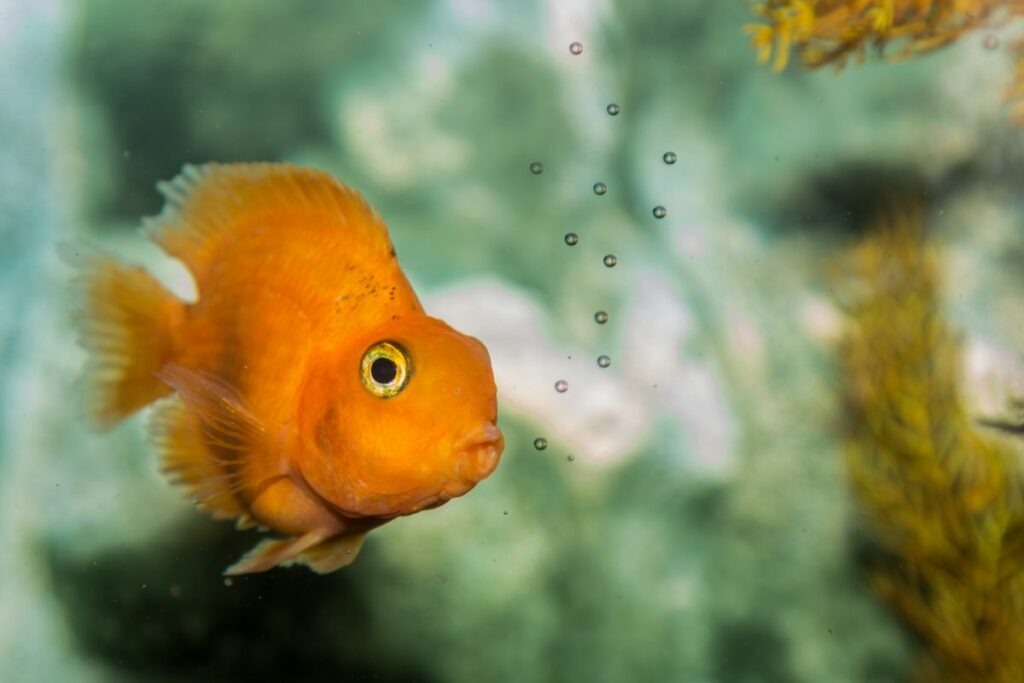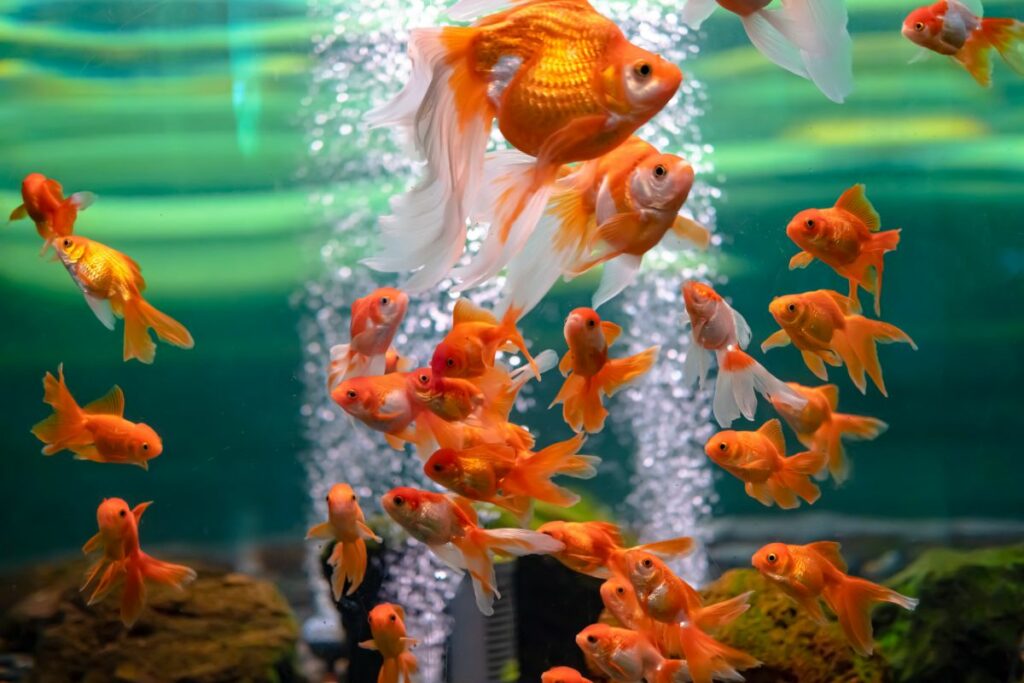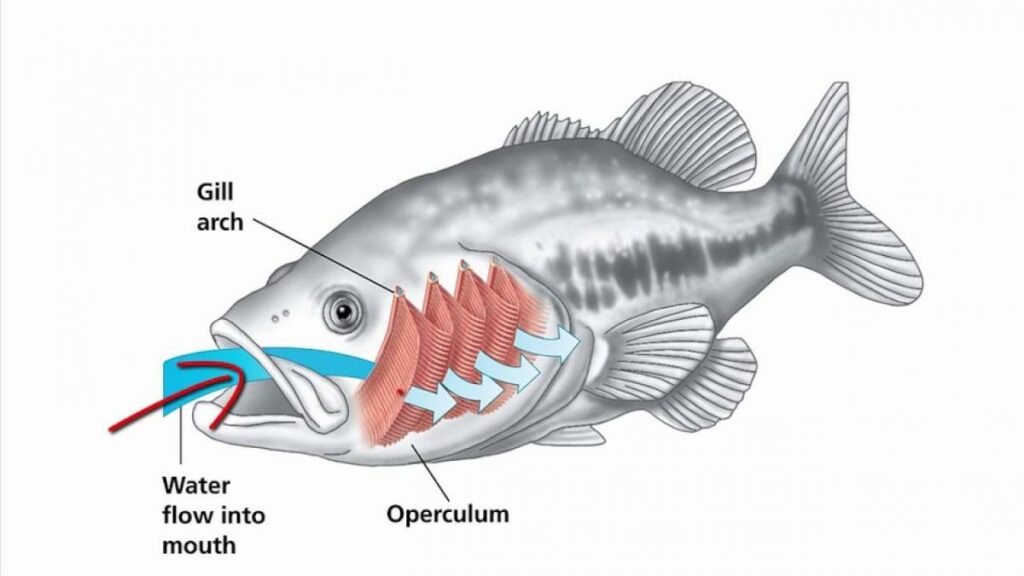Fish live in water, so asking if fish can drown may seem like a silly question. While fish cannot drown like humans do, they can suffocate underwater if the water doesn’t contain enough oxygen.

Suffocation is rare, but it happens most often when fish tanks are dirty and high in toxins or if they don’t have enough aeration. Instances of suffocation in the wild are similar, with “dead zones” occuring where there isn’t sufficient oxygen.
What Does It Mean To Drown?
Fish don’t drown in the same sense that humans do. To breathe, we inhale air into our lungs, and we drown because we inhale while underwater, and water fills our lungs.
While underwater, we may accidentally inhale water. Once the water enters our airways, it causes our airways to close. The lack of oxygen causes us to lose consciousness, at which point water fills our lungs.
Hackensack Meridian Health describes another way humans can drown:
“A person will experience a laryngospasm, where the vocal chords spasm and seal that pathway. This can be seen in many drowning instances, especially when someone is trying to hold his or her breath underwater.”
How Do Gills Work?
Fish don’t have lungs, so they can’t drown like humans do. But, like us, fish need oxygen to breathe.
Fish have gills which are branched organs on either side of the head. Water flows over the gills when the fish opens its mouth.
Gills comprise feather-like tissue that acts like a screen or filter when taking in water. Within those tissues are tiny blood vessels called capillaries, and the blood soaks up the oxygen from the water. The oxygen flows throughout the body with the blood, distributing it to the fish’s organs.
As the capillaries absorb oxygen from the water, the gills also expel waste like carbon dioxide and ammonia back into the water.
It’s much harder for fish to get oxygen from the water than for us to breathe. The Ocean Conservancy explains why that is:
“The air we breathe has an oxygen concentration of 200,000 parts per million. Water, on the other hand, only has a concentration of 4 to 8 parts per million. That means fish need to run a lot of water over their gills to get the amount of oxygen they need to survive. Also, gills are very efficient in extracting the oxygen the fish needs!”
Can Fish Drown?
Surprisingly, fish “drown” — aka suffocate — in much the same way that humans do. We drown from a lack of oxygen, and fish suffocate from a lack of oxygen.
You can’t drown a fish by placing them in water since water is its habitat. Without water, a fish suffocates. But fish need to absorb oxygen from the water, and if the water doesn’t contain enough oxygen, they can suffocate — or drown.
Water may contain as little as 100 times less oxygen by volume than air. The amount of oxygen water contains depends on the salinity and temperature, among other environmental factors.
Poor Gas Exchange
The atmosphere contains more oxygen than water, so oxygen needs to dissolve in the water for fish to use it.
For oxygen to enter water, there needs to be gas exchange at the surface. Gas exchange occurs when there is surface agitation, allowing the oxygen from the air to enter the water column.
It’s important to have moving water in your aquarium to produce oxygen. Stagnant water contains little oxygen and is dangerous for most fish species.
Filters and aerators are wonderful for adding oxygen to your tank. In smaller aquariums, filters often create enough surface agitation to provide your aquarium with oxygen. Most larger tanks, and some small tanks need addition bubblers to produce oxygen.
How Do Bubblers Work?
People often misunderstand how bubblers work. They produce bubbles that float from the bottom of the tank to the surface. The bubbles floating through the water do nothing to add oxygen to the water, though.

The bubbles add oxygen to the water when they reach the surface and pop, facilitating gas exchange with the atmosphere.
Fish that prefer slow-moving water still need surface agitation to receive oxygen. You can lower the flow rate and direct the water to an area of the tank where your fish don’t go often. Doing so will prevent the current from bothering your fish.
Why Warm & Stagnant Water Is A Problem
A stagnant aquarium doesn’t allow for proper oxygen exchange, so your fish may not be getting enough oxygen, and is surrounded by too much carbon dioxide. Fish can suffocate when oxygen concentrations are too low in an aquarium.
Proper aeration is more important in warm water than in cold water because warm water doesn’t hold oxygen as well. You’re more likely to need a bubbler in your tropical tank than in your cold-water goldfish tank.
Suffocating From Poor Water Quality
Poor water quality occurs in an aquarium when you don’t take care of your fish’s habitat. Fish constantly produce waste, and they’re swimming around in their waste, so regular water changes are necessary.
You should replace about 25% of your aquarium’s water once every one to two weeks. Using a gravel vacuum is your best option so you can remove the fish poop that has sunk into the the substrate.
Filters with biological, mechanical, and often chemical filtration are necessary too as they remove waste from the water.
Mechanical filtration removes large waste from the water like fish poop. Biological filtration refers to the good bacteria that lives in your tank and removes toxins like ammonia and nitrites. Chemical filtration isn’t always necessary, but is helpful as it also removes toxins from the water.
Aquariums that don’t receive regular cleanings become dirty, and toxins build up in the water column. Any amount of ammonia and nitrite are toxic to fish and can cause them to suffocate. Nitrates are less toxic, but can still suffocate your fish at higher concentrations.
Oxygen Depletion In the Wild
Changes in the environment can cause water to lose oxygen as well. Plankton blooms occur when a body of water suddenly has an abundance of nutrients. The plankton rapidly absorb all the oxygen, causing the fish in the area to die.
Climate change is also wreaking havoc on certain areas of the ocean, creating “dead zones” that don’t have enough oxygen to sustain life. Warm water doesn’t hold as much oxygen as cold water, and as our oceans become warmer, dead zones are becoming more common.
“Drowning” In Air
Since fish have gills, not lungs, they suffocate when out of water for too long. There’s more oxygen in the atmosphere, but gills lack the support and moisture they need to function properly.
How fast fish suffocate in air depends on their metabolism, size, and how well adapted they are to low-oxygen conditions. Most fish species can survive no longer than 10 minutes outside of water. Freshwater species seem to suffocate quicker than brackish and saltwater species.
Fish That Breathe Air Survive Longer
Some fish, like bettas and gouramis, have labyrinth organs that allow them to breathe air in addition to water. The labyrinth organ extends from the gill plates and allows fish to take oxygen directly from the atmosphere.
Without a lid, bettas sometimes jump out of their tank. As long as their bodies don’t dry out, they may survive upwards of one to two hours outside of their tank.
Most fish only use their swim bladders to control their buoyancy. Saltwater tarpons and freshwater arowans use their swim bladders as primitive lungs. Blood vessels line their swim bladder to absorb oxygen when the fish inhale oxygen into their swim bladder. No one is sure how long they can survive outside water, but it’s likely much longer than most fish.
Lungfish, bichirs, and reedfish have real, human-like lungs to inhale water from the atmosphere. Their lungs increase gas exchange throughout the body, and are useful when there is not enough oxygen in the water for the gills to absorb.
Lungfish are so incredible they can live up to a year outside of water. Without the presence of water, lungfish secrete a thick mucous that encases the body and dries into a cocoon. They use their lungs to breathe for up to a year until the water comes back.
Damaged Gills

Fish can suffocate if their gills are injured because the gills can’t function properly to take in water. Without water going through the gills, fish cannot absorb oxygen and suffocate.
LiveScience explains the most common ways in which fish get damaged gills:
“Fishing equipment, such as some types of hooks, can damage the gills. Disease can also be the cause. Pathogens, mainly bacteria, may attach to the gills, blocking them so they can’t filter oxygen from the water or degrading them to the point where they no longer work.”
Entrapment
Most fish cannot pump water through their gills when in a resting position; they must constantly swim to take in water and absorb oxygen.
Fish that become trapped in a net or behind a dororation in a tank can quickly suffocate if they don’t free themselves.
One of the most horrific examples of fish suffocation occurs regularly to sharks. Shark fins are a delicacy in many Asian countries. Fishermen catch sharks and cut off their fins for shark fin soup, but do not use the rest of the body. The still-alive shark is thrown back into the water.
Sharks cannot swim without their fins, and they cannot breathe when they’re not swimming. Because their fins have been cut off, sharks sink to the bottom of the ocean, slowly suffocating and often being eaten alive by other marine life.
Why Does This Matter For Our Pet Fish?
It’s rare for fish to run out of oxygen in a home aquarium, but it’s possible. The best way to prevent your fish suffocating is ensuring you maintain a clean and healthy enviornment inside the aquarium.
Symptoms Of Oxygen Deprivation
Your fish will provide you with obvious signs if they’re not receiving enough oxygen, so you must pay attention. Fish can’t survive long on low levels of oxygen, so if the water is lacking oxygen, you need to correct the situation as quickly as possible.
Water near the surface of your tank contains more oxygen than the deeper areas of your tank. Fish, like goldfish and tetras, prefer swimming in the middle of the water column. It’s not normal to see them spending a lot of time at the top of the tank; such behavior probably indicates there’s not enough oxygen in the water.
Similarly, if your fish spend a lot of time at the surface gasping for air, that’s a clear indication there’s not enough oxygen in the tank. You’ll also see your fish fluttering their gills rapidly trying to absorb oxygen from the water.
Conclusion
Technically, fish don’t drown — they suffocate. Fish need oxygen like us, but rather than breathing through lungs, fish absorb oxygen from the water with their gills.
Fish are most likely to suffocate if water conditions are toxic and oxygen-poor. The most effective way of preventing suffocation is providing your fish with a clean, aerated environment.
FAQs
Most likely, your tank has poor water conditions with high concentrations of toxins and low oxygen levels. Test your water conditions, and if everything is fine, then your fish may have a fungal, bacterial, or parasitic infection. Temporary heavy breathing may just be a result of another fish chasing them around the tank.
Most fish only have gills, so they can’t breathe out of water. Some fish — like bettas, arowans, and lungfish — have special organs that allow them to breathe air from the atmosphere in addition to absorbing it through their gills. Fish adapted to breathing air can survive outside of water much longer than normal fish.
It’s unlikely that a fish will suffocate if they swim too deep. Deeper water contains less oxygen than water at the surface, but if they’re lacking oxygen in deep water, fish will simply swim closer to the surface. The only time a fish is likely to drown from swimming too deep is if they get trapped somehow.
